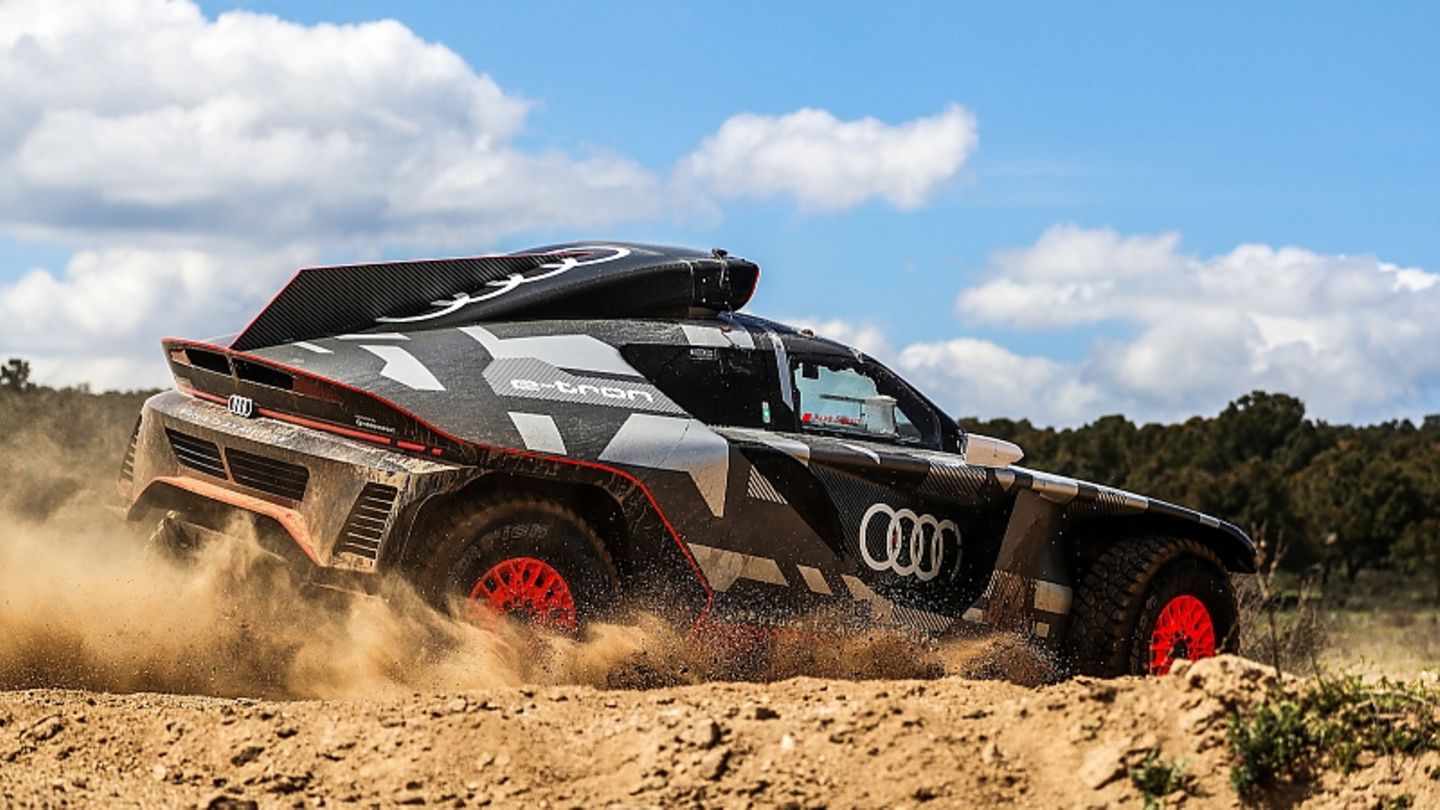Electric through the desert? The Audi RS Q e-tron can do it – not thanks to its mega range, but with the help of an onboard power generator. We were allowed to try the bullet from the Dakar Rally.
It was a bit like the first moon landing, Sven Quandt compares the creation of the Audi RS Q e-tron for the 2022 Dakar Rally: a leap into the unknown. Quandt should know. Not only did he himself drive the toughest rally in the world as a pilot, but his company has already put the vehicles of several manufacturers on the road to success for the desert marathon. He is currently the deployment and development team for Audi. But the Ingolstadt company’s approach is completely new. The Audi RS Q e-tron is powered fully electrically. The required electricity is generated on board. The three vehicles did only a respectable job at the rally at the beginning of the year: four stage victories, a total of 14 podium results on the stages and ninth place in the final standings for the Mattias Ekström / Emil Bergkvist duo are impressive. The result would certainly have been even better if some typical mechanical teething problems hadn’t caused problems on the first few days.
When Audi speaks of the most complex racing car in the history of the brand, that is no exaggeration. The RS Q e-tron was created on a blank sheet of paper, with no model and limited only by a relatively vague set of rules. Rather, the pandemic and the tight time frame caused restrictions when the starting signal was given in July 2020. Internal doubters also had to be convinced, the number of which even increased after the first simulation of a Dakar stage on the computer. But the Audi technicians, from whose ranks the idea came, finally had the right instinct: the car works and is fast. It’s definitely a stroke of genius.
The Dakar-Audi is powered by two electric motors, each with a theoretical maximum output of 340 hp. Due to the regulations, however, the total output is limited to 392 hp. A differential lock on each axle, in conjunction with a virtual center differential, ensures that each wheel receives just as much power as needed, controlled by the software. The alternative of equipping each wheel with its own electric motor and thus saving on the gears was rejected in the initial phase of the project. “In the event of chassis damage, as can happen in rally raid sport, the 800-volt power system would also be affected. That would mean the end,” explains Benedikt Brunninger, the technical project manager.
The motors are powered by a powerful 52 kWh battery. Of course, that’s not nearly enough for the total distance of more than 8,000 kilometers, not even for the daily stages. Reloading during the rally is not an option, especially in the desert. This gave the engineers the idea of using a combustion engine to produce the electricity themselves on the go. That would not be new in itself and has been done on ships and trains for decades with low-speed diesel engines. The highlight at Audi is that the mothballed engines from the DTM were reactivated. “There was no alternative in terms of weight or performance, and certainly not in the tight time frame,” Brunninger clarifies. It remains secret how much power the formerly over 600 hp units have today. What is certain is that they are extremely compact, work highly efficiently and have been extensively modified for their desert missions in terms of turbocharger, manifold, exhaust system and software. The sound of the aggregates, on the other hand, is completely unusual: They start automatically as required and then run along at around 4,000 to 6,000 revs. It doesn’t matter whether the driver is braking or accelerating, which is why the soundscape has something strange – just as if the neighbor was working unstoppably and monotonously with his hammer drill. Without the active four-cylinder, the RS Q e-tron has a sound that also gives you goosebumps: It’s whirring and whistling like a mixture of beaming and jumping into hyperspace.
Anyone who accuses the Audi RS Q e-tron of greenwashing, driving electrically, promoting electromobility, but ultimately burning petrol again, has not grasped the central point: the electric drive is unbeatable off-road. Its high torque is available from the first fraction of a second. This is an invaluable advantage when overcoming obstacles or on steep inclines. In this discipline, plug-in hybrid off-road vehicles also outperform their conventionally powered counterparts. “But it’s not just this immediate boost alone,” clarifies Emil Bergkvist, who as co-pilot not only shows us the way, but also makes it clear with understandable tips where you can get even more out of the RS Q e-tron. “Equally important is the extreme responsiveness of the system, especially when driving in dunes. Because we don’t know what’s behind the crest of the dunes, we have to be slow there. If we are too fast and it goes steeply downhill, there is a risk of a rollover. On the other hand, we need boost to get up. That can be dosed much more precisely with the electric drive.” Sure: In conventional vehicles, the right speed has to be found first, while shifting gears in the dunes is crap anyway. “We’re not talking about two or three dunes, but maybe 200 per stage,” emphasizes Bergkvist the advantage. No wonder that even the 2022 Dakar winner, Nasser Al-Attiyah in the conventional Toyota Hilux, rates the Audi as the fastest car in the field.
In any case, the RS Q e-tron has endless thrust, and inertia is a foreign word to it. He does immediately what the driver asks. On the Sardinian gravel of the test track, he likes to do this with a lot of understeer – until you give him the necessary impetus with a handbrake that only looks classic. Due to her very own progression, this takes a bit of practice. But otherwise the Dakar-Audi drives good-naturedly, almost well-behaved – apart from the exuberant multifunction displays, which fortunately the co-pilot keeps an eye on. Measured against the revolution that the car represents and its complexity, the Audi RS Q e-tron is really easy to control – even if your name is not Carlos Sainz, Stéphane Peterhansel or Mattias Ekström and you are not an Audi works driver.
Source: Stern
I am a 24-year-old writer and journalist who has been working in the news industry for the past two years. I write primarily about market news, so if you’re looking for insights into what’s going on in the stock market or economic indicators, you’ve come to the right place. I also dabble in writing articles on lifestyle trends and pop culture news.




